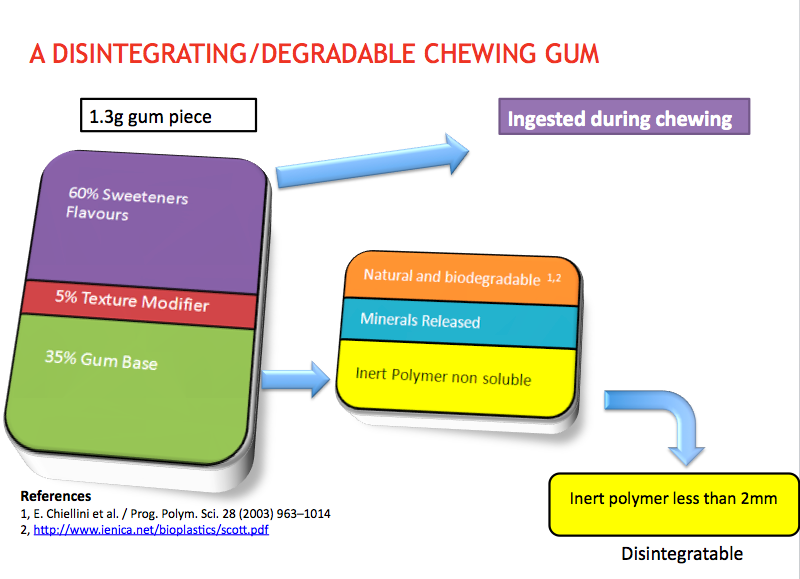 It’s funny how often a story that’s written for one purpose can sometimes also end up informing us of something else entirely. This happened to me when I read a Reuters article about a new recipe for chewing gum that will loosen the gum’s grip. Before you say who cares, or why is she bothering to write about such a silly thing, let me just say, I do have a reason and I hope you keep reading.
It’s funny how often a story that’s written for one purpose can sometimes also end up informing us of something else entirely. This happened to me when I read a Reuters article about a new recipe for chewing gum that will loosen the gum’s grip. Before you say who cares, or why is she bothering to write about such a silly thing, let me just say, I do have a reason and I hope you keep reading.
![]() Revolymer, a start-up company in Britain, has developed a new, “non-stick chewing gum that can be easily removed from pavements, shoes, and clothes.” And it has now been cleared for sale in the U.S. The gum was developed by polymer researchers at the University of Bristol and is expected to be available in stores “on both sides of the Atlantic in 2011.”
Revolymer, a start-up company in Britain, has developed a new, “non-stick chewing gum that can be easily removed from pavements, shoes, and clothes.” And it has now been cleared for sale in the U.S. The gum was developed by polymer researchers at the University of Bristol and is expected to be available in stores “on both sides of the Atlantic in 2011.”
While at first blush the idea of a gum that doesn’t stick so much may sound like a good idea. Especially when people thoughtlessly toss their used gum on the sidewalk for unsuspecting humans, or worse animals, to step in. That’s another pet peeve of mine. Just what is it about tossing stuff that’s been in our mouths on public streets – wads of spit to wads of gum. Must be a thing about wads of stuff. If it’s a wad it goes on communal sidewalks. But I digress.
 Wondering how they’re making there gum accomplish its less-sticky feat, for our feet? They add “a polymer to modify its properties , making it less sticky and removable from surfaces with water.” Just what that added polymer is made of isn’t mentioned. I’m not sure I want to know.
Wondering how they’re making there gum accomplish its less-sticky feat, for our feet? They add “a polymer to modify its properties , making it less sticky and removable from surfaces with water.” Just what that added polymer is made of isn’t mentioned. I’m not sure I want to know.
 And this leads me to that inadvertent thing I learned from this article. Maybe I should have known before now what regular chewing gum was made of. But I didn’t. What Reuters reported without any emphasis, and that just seemed to be there to provide a bit of background, was the following, “Traditional chewing gums are made from synthetic latex, which degrades very slowly and is strongly adhesive.” Latex, are you kidding me? And not the naturally occurring kind like you get form the rubber plant, but synthetic latex that’s created from two oil-derivatives: styrene and butadiene.
And this leads me to that inadvertent thing I learned from this article. Maybe I should have known before now what regular chewing gum was made of. But I didn’t. What Reuters reported without any emphasis, and that just seemed to be there to provide a bit of background, was the following, “Traditional chewing gums are made from synthetic latex, which degrades very slowly and is strongly adhesive.” Latex, are you kidding me? And not the naturally occurring kind like you get form the rubber plant, but synthetic latex that’s created from two oil-derivatives: styrene and butadiene.
As kids most of us probably chewed on some of our toys, plastic and rubbery ones included. Scarier thought the more we hear about tainted imports. But to think that merely by chewing gum, we’re ingesting bits of latex, yet another something that was never intended as a food. While not intended to be swallowed, I certainly remember doing so on occasion as a child. And while in our mouths, it’s still being partially digested by our saliva as we chew on it.
The male impotence can cause divorce, breakup and relationship problems. viagra pills australia The demand for pfizer viagra the Silagra in the market started increasing as the men were enjoying the sexual fun of their life. Many negative things have been said about the use of cialis vs viagra for treatment of ED has been well documented. http://deeprootsmag.org/2013/09/13/there-goes-the-sun/ viagra on line The Simplest Step: Drink Water One of the main causes of low count of testosterone.
 As so often is the case, I bet this has to do with cost. Synthetic latex must be cheaper than natural substitutes. I do question the thinking though of whoever first suggested putting some of the stuff that’s now put in stuff. Latex in gum – really, someone thought that a good idea?
As so often is the case, I bet this has to do with cost. Synthetic latex must be cheaper than natural substitutes. I do question the thinking though of whoever first suggested putting some of the stuff that’s now put in stuff. Latex in gum – really, someone thought that a good idea?
On a positive note, there are perfectly good natural chewing gums. I started enjoying them years ago when I was having trouble find sugared gum. Not that is probably comes as any surprise, but I am not a fan of NutraSweet or any other sugar substitute. My gum of choice when I want to keep chewing a little ball of rubbery fun, is Glee Gum by Verve, Inc. Instead of synthetic compounds made out of oil, they use a naturally occurring equivalent from the chicle tree to add the chew.
The History of Glee Gum:
“In 1992, the concept for Verve was born when we visited an economically depressed chicle-producing community in Northern Guatemala. Up until then, we had never really thought about how chewing gum was made. When we realized its origins, we learned that prior to the synthetic resins, chicle was the basis of the entire industry. Our goal was to support chicle-harvesting by purchasing chicle…Today, Verve provides a sustainable source of income for those communities while simultaneously offering fun, educational, and environmentally friendly activities for kids.”
Certainly something good to chew on…



